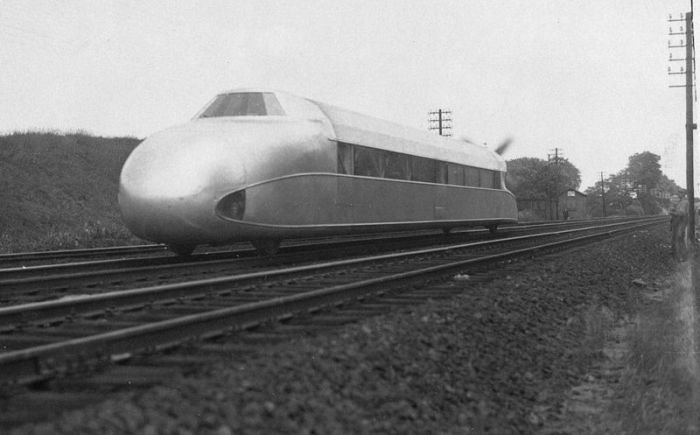|
|
Schienenzeppelin By Franz Kruckenberg, Germany
|
The train was built at the beginning of 1930 in the Hannover-Leinhausen works of the German Imperial Railway "Deutsche Reichsbahn" company. The work was completed by autumn of the same year. The train was 25.85 metres (84.8 ft) long and had just two axles, with a wheelbase of 19.6 m (64 ft). The height was 2.8 metres (9 ft 2 in). As originally built it had two conjoined BMW IV 6 cylinder petrol aircraft engines (later a single BMW VI 12 cylinder of 600 horsepower (450 kW)) driving a four-bladed (later two-bladed), fixed pitch wooden (ash tree) propeller. The driveshaft was raised 7 degrees above the horizontal to give the vehicle some downwards thrust. The chassis of Schienenzeppelin was designed aerodynamically having some resemblance to the era's popular Zeppelin airships and it was built of aluminum in aircraft style to reduce weight. The railcar could carry up to 40 passengers, its interior was spartan and designed in Bauhaus-style.
On 10 May 1931, the train exceeded a velocity of 200 km/h (120 mph) for the first time. Afterwards, it was exhibited to the general public throughout Germany. On 21 June 1931, the train set a new world railway speed record of 230.2 km/h (143.0 mph) on the Berlin–Hamburg line between Karstädt and Dergenthin, which was not surpassed by any other train until 1954. The railcar still holds the land speed record for a petrol powered rail vehicle. This high speed was attributable, amongst other things, to its low weight, which was only 20.3 tonnes (20.0 LT; 22.4 ST).
In 1932 Kruckensberg began a new project with the rail car involving significant modifications. It was cut just behind the forward wheels and received a complete new front end with a two-axle bogie, resembling the later 137 155 railcar. The rear single axle remained as it was. The modifications were completed by November 1932. The aircraft engine was still used, however, the power transmission was hydraulic through two Fottinger- Fluid drives for both directions of travel, these were fitted on the forward bogie. A pointed fairing was installed in place of the propeller. These changes meant that the earlier 1-1 wheel arrangement was replaced by B-1 with the front axle replaced by a powered bogie.This version of the vehicle reached 180 km/h (110 mph) at the beginning of 1933.
Due to many problems with the Schienenzeppelin prototype, the Deutsche Reichsbahn-Gesellschaft decided to go their own way in developing a high speed railcar. In 1933 the DRG built a high-speed railcar of their own design and called it Fliegender Hamburger (Flying Hamburger). DRG's new design was suitable for regular service and served also as the basis for later railcar developments. However, many of the Kruckenberg ideas, based on the experiments with Schienenzeppelin and high speed rail travel, found their way later to DRG's railcar designs.
|
|









